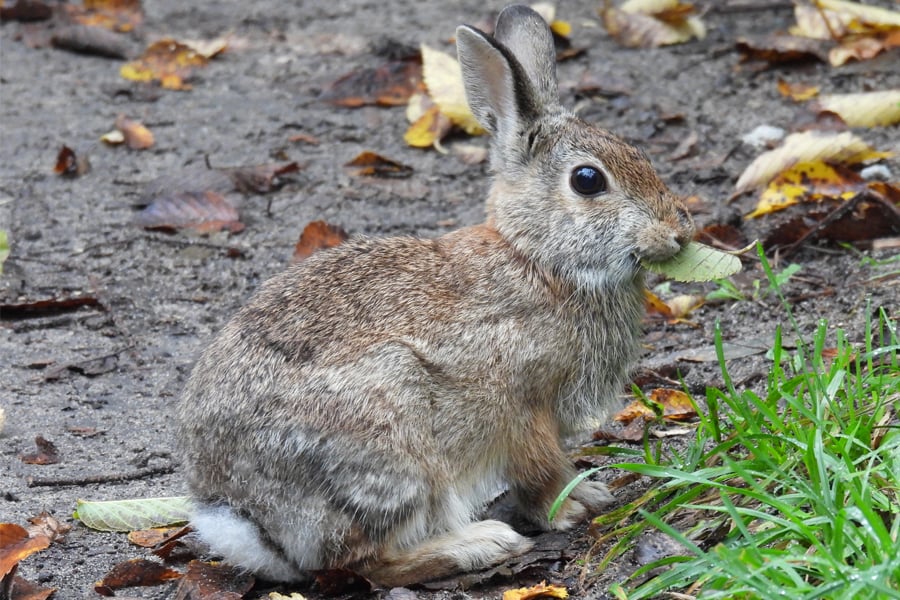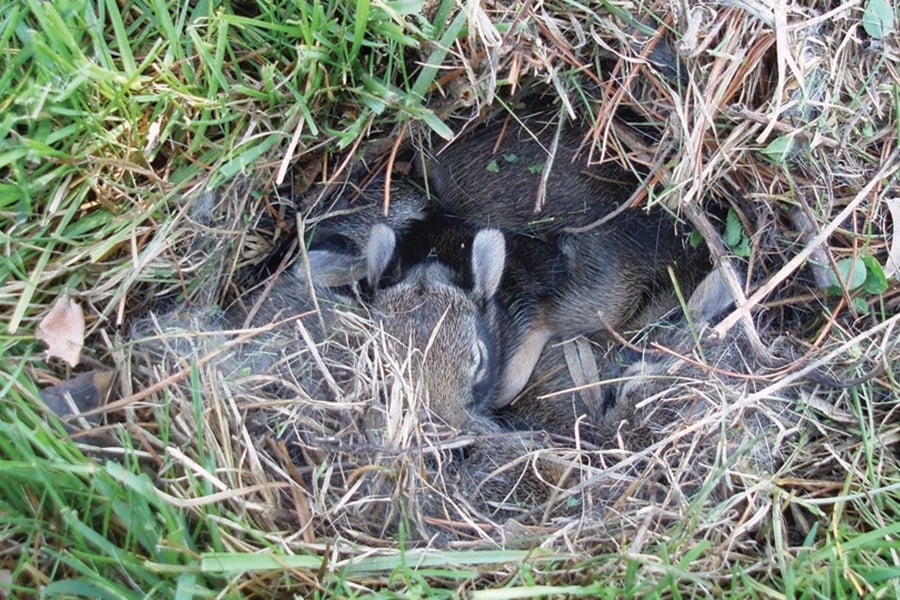Living With Eastern Cottontails
This page provides problem-solving advice and ways to make your yard less attractive to eastern cottontails in the first place.

Don't Look for Mom
You shouldn’t expect to see the mother. She only feeds her young once or twice a day and usually at night. Otherwise, she stays away so she doesn’t bring attention to the nest, a defense strategy that many species use.
Because the female stays away for so long, people may think her young are orphaned, but a female can raise an entire litter without ever being seen.
If you're still concerned, you can check to see if the mother returns.
- Lightly place string or twigs over the nest in a tic-tac-toe pattern, and leave them overnight. If the strings are disturbed in the morning, the mother has likely been there to feed her babies.
- See if the young look generally healthy, if they’re warm and active with rounded bellies. If so, the mother is present.
- If the babies are cold and lethargic and have flattened bellies, this could indicate that something has happened to the mother. Call Willowbrook Wildlife Center at 630- 942-6200 for assistance.
How to Return Young to the Nest
You can reunite young cottontails with their mother if they have not been separated for more than 36 hours.
- Gently place the young back in the nest. It’s okay to handle them with gloved hands. The mother will not reject them.
- Cover the young with any leftover nesting fur and dried grass.
- Leave the nest alone. Frequent activity around the nest can force the mother to abandon it.

if babies this young squirm out of their nest and are uninjured, simply place them back.
Pets & Cottontails
Never remove baby animals from their mothers’ care solely because pets are in the area. As a pet owner, your most responsible option is to keep cats indoors and to let dogs outside only under direct supervision.
Each year, free-roaming cats — domestic as well as feral — kill millions of wild animals nationwide. Even declawed and well-fed cats are instinctively proficient hunters, so always keep cats indoors.
If the nest is in an area where a dog commonly stays, such as a backyard or dog run, place a laundry basket secured with a heavy object, such as a large rock, over the nest during the day. Remove the basket at dusk so the mother can return to feed at night, and replace the basket again in the morning. Repeat this until the young are on their own.
How to Make Your Yard Less Attractive
- Never feed eastern cottontails.
- Install a 2-foot-high wire fence around your garden. Secure the bottom by burying it 6 to 8 inches underground or by driving stakes in the ground at even intervals to prevent cottontails from pushing underneath.
- Plant onions, flowering onions, garlic, fritillaria or tropaeolum around the perimeter of your garden. They have unpleasant tastes or smells that might keep cottontails away.
- Spray plants with a mixture of 1 gallon of water and 2 tablespoons of hot sauce or garlic puree. Reapply after a heavy dew or rain.
What You Should Never Do
- Trapping and removing an animal is not always the solution to the problem. Removing the animal is illegal without the proper permits and only creates an open space for another animal to inhabit. A trapped adult may also leave young behind to die of starvation. Focus on removing the attraction, not the animal.
- Never move young from a den.
- Never use poisons. They’re inhumane and may be illegal. They can also result in secondary poisoning of other wild animals or pets.
- It’s illegal to keep wild animals, even for a short time. They have special nutritional, housing and handling needs, and inexperienced individuals who try to raise or treat them inevitably produce unhealthy, tame animals that can’t survive in the wild.
Public Health Concerns
Eastern cottontails are not a public health concern.